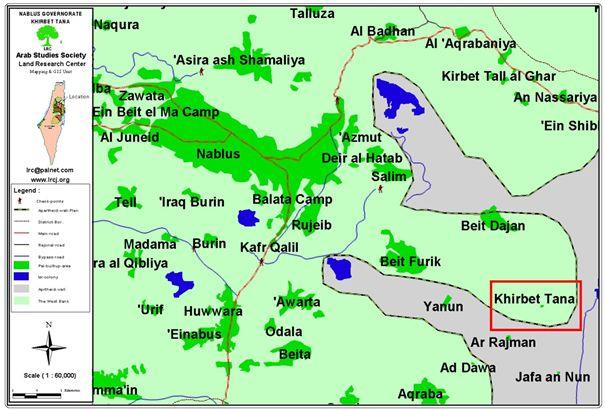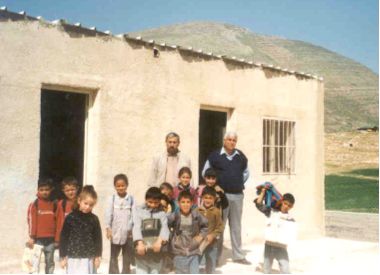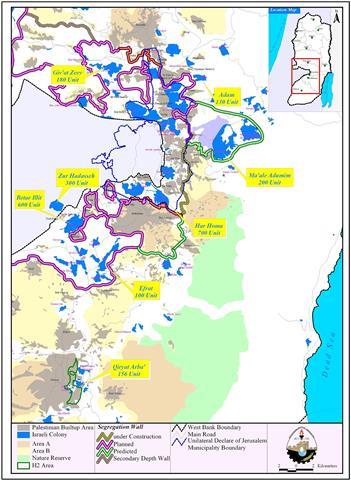Location and Population
Tanna Hamlet is located 7 kilometers to the east of the town of Beit Furik, Nablus. The population of this Hamlet is divided into farmers and herd owners as they tend to the Hamlet every season especially during the winter and spring seasons. Due to the fact that the Hamlet is far from Beit Furik, the residents stay in it to tend to their sheep and to plant their fields with barley and wheat. As such, the number of residents in Tanna during spring period ranges between 50 and 70 families. See map of location
Tanna Hamlet( Tanna Hamlet) ( in red quadrangle) surrounded by the planned Separation Wall
Area:-
The area of Tanna is approximately 7,500 dunums of which 2,500 dunums are used to plant wheat and barley while the remaining 5,000 dunums are used for grazing.
Colonial Violation:-
Israeli warning for the resident of the Hamlet to vacate it.
Date of Violation: 29/3/2004
Details of the Warning:-
On the said date 3 Israeli military jeeps reached Tanna Hamlet and ordered the residents to leave the area immediately. In an interview with LRC's filed worker, farmer Fozan Musa Nasasreh (60 year old) said: ' The soldiers acted in a barbaric fashion. They shouted in loud voices to terrorize the children and the women. They have searched my cavern and shed thoroughly. They were bad-tempered as the captain of the patrol told me to leave the area within a week along with the rest of the residents. He informed me that if we do not leave voluntarily, the soldiers would use force to evict us'.
He added that:
' The warning period passed by and non of the residents left. We have informed the municipality of Beit Furik which, in turn, informed the Palestinian Liaison Office and the Governerate of Nablus'.
Social Services in Tanna Hamlet
-
There is a one-room old mosque in the area of which is 50 m2. The age of the mosque is about 150 years. See Photo 1
Khirbet Tanna- Nablus- The old mosque of Tanna, Photo courtesy of LRC
-
There is an elementary school established in 2001. It consists of two rooms which were used as a kindergarten. The residents of Tanna submitted a request to the Palestinian Ministry of Education to turn it to a school. The Ministry of Education approved the request and schooling started this year 2003-2004. See Photo 2
Khirbet Tanna- Nablus- Teachers and pupils standing in front of the modest building of Tanna school, Photo courtesy of LRC
Water Sources
There are three old springs in Tanna. A water collection tank was placed to gather water from the upper and lower springs. The middle spring went dry a while ago. The residents use these springs for both human and animal drinking.
Tanna's Dwellings
The residents of Tanna live in caverns, sheds, huts as well as tents.
Khirebt Tanna- Nablus- A general view of Tanna dwellings and the school, Photo courtesy of LRC
Series of Israeli Violations
Since the Israeli occupation of the West Bank in 1967 a series of Israeli violations against the residents of Tanna has been committed, including:
-
In 1970, the Israeli Army declared the east of Tanna as a closed military zone to be used for military practices. The closed-down area was estimated at that time to be 10,000 dunums of fertile lands.
-
In 1979, the settlement of Mekhora was established on Beit Furiks' lands. Thousands of dunums were confiscated for that purpose.
-
Since the beginning of Al Aqsa Uprising in 2000 the Israeli Army has increased its skirmishes against the residents of the Hamlet. Such confrontations included, among other things, sheep confiscation and high fines to force the residents to leave.
-
The closure of all roads leading to Tanna as to prevent its residents from using cars and trucks necessary to transport crops and the like.
-
Ruining agricultural crops using military heavy machines.
-
Beating up farmers and destroying their property. Case in point is what took place to the 52-year-old Mohammad Tawfiq Adel Nasasreh who was brutally beaten by Israeli soldiers in October 2003. Not satisfied by only beating him the soldiers emptied about 100 barley-filled bags as well as destroying his tent leaving him and his family homeless.
Social and Economic Effects
The Tanna region is a large agricultural and grazing basin. It is estimated that 10,000 sheep and more than 200 cows graze the lands of Tanna on yearly basis. As for agricultural lands, there are more than 2,500 dunums planted mainly with barley which produces food for both Tanna and Beit Furik. If Israel was to control these lands, it would be considered as a major economic disaster for both the residents of Tanna and Beit Furik.
Khirebt Tanna- Nablus- Two citizens of Tanna standing out side the old mosque, Photo courtesy of LRC
Prepared by
The Land Research Center
LRC



















